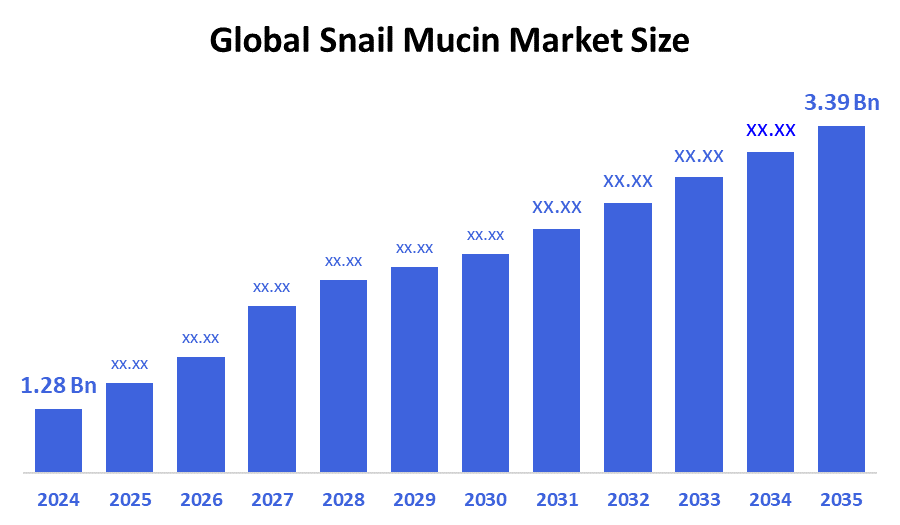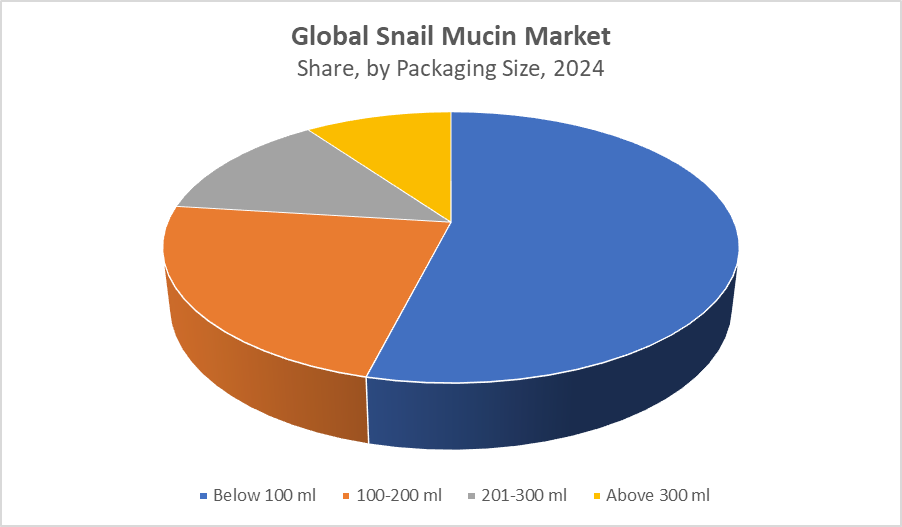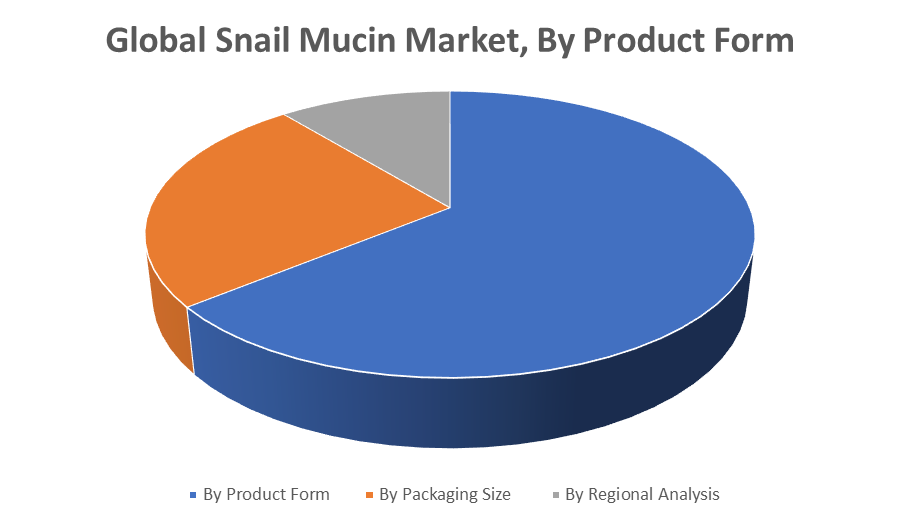Global Snail Mucin Market
Global Snail Mucin Market Size, Share, and COVID-19 Impact Analysis, Impact of Tariff and Trade War Analysis, By Product Form (Snail Mucin Serums, Snail Mucin Creams & Moisturizers, Snail Mucin Face Masks, and Snail Mucin Cleansers & Toners), By Packaging Size (Below 100 ml, 100-200 ml, 201-300 ml, and Above 300 ml), and By Region (North America, Europe, Asia-Pacific, Latin America, Middle East, and Africa), Analysis and Forecast 2025 - 2035
Report Overview
Table of Contents
Snail Mucin Market Summary, Size & Emerging Trends
According to Spherical Insights, the Global Snail Mucin Market Size is Expected to Grow from USD 1.28 Billion in 2024 to USD 3.39 Billion by 2035, at a CAGR of 9.26% during the forecast period 2025-2035. A key growth factor is rising demand for natural, multifunctional skincare products.

Key Market Insights
- Asia Pacific is expected to account for the largest share in the snail mucin market during the forecast period.
- In terms of product form, the snail mucin creams & moisturizers segment accounted for the largest market share of the global snail mucin market during the forecast period
- In terms of packaging size, the below 100 ml segment accounted for the major revenue share of the global snail mucin market during the forecast period
Global Market Forecast and Revenue Outlook
- 2024 Market Size: USD 1.28 Billion
- 2035 Projected Market Size: USD 3.39 Billion
- CAGR (2025-2035): 9.26%
- Asia Pacific: Largest market in 2024
- North America: Fastest growing market
Snail Mucin Market
The snail mucin market is rapidly growing, driven by rising consumer demand for natural and effective skincare ingredients. Snail mucin, a secretion from snails, is prized for its rich content of glycoproteins, hyaluronic acid, and glycolic acid, which help promote skin hydration, elasticity, and regeneration. It is widely used in various cosmetic products such as facial creams, serums, lotions, and masks. Governments in some countries have introduced initiatives to support the natural cosmetics industry, encouraging sustainable sourcing and innovation in bio-based ingredients like snail mucin. These efforts aim to boost economic growth and promote eco-friendly beauty solutions. The market continues to expand as consumers increasingly seek multifunctional and natural skincare products. Innovation in product formulations and growing awareness of snail mucin’s benefits have strengthened its presence in the global beauty industry, making it a key ingredient in modern skincare routines.
Snail Mucin Market Trends
- Personalized skincare products tailored to individual skin needs using advanced tech.
- Combining snail mucin with other natural ingredients like hyaluronic acid for enhanced benefits.
Snail Mucin Market Dynamics
Driving Factors: Increasing consumer demand for natural, cruelty-free skincare products
The snail mucin market is driven by several key growth factors. Increasing consumer demand for natural, cruelty-free skincare products fuels its popularity, as snail mucin is recognized for its hydrating, anti-aging, and skin-repair properties. Rising awareness of multifunctional skincare ingredients boosts its adoption across various products like creams, serums, and masks. The influence of K-beauty trends globally also contributes to market expansion. Additionally, innovations in extraction and formulation techniques enhance product effectiveness and appeal. Government support for sustainable and bio-based cosmetic ingredients further encourages market growth, making snail mucin a preferred choice in modern skincare.
Restrain Factors: High production costs and complex extraction processes
Restraining factors in the snail mucin market include ethical concerns related to snail welfare during mucin extraction, which can affect consumer perception and demand. High production costs and complex extraction processes limit large-scale manufacturing and increase product prices. Additionally, a lack of standardized regulations and quality control poses challenges for consistent product efficacy and safety. Some consumers may also be hesitant due to unfamiliarity or skepticism about the ingredient’s benefits. Lastly, the availability of synthetic and plant-based alternatives offers competition, potentially slowing the growth of traditional snail mucin products in the skincare industry.
Opportunity: Expanding applications beyond facial skincare
Growing consumer interest in natural and sustainable beauty products creates demand for innovative snail mucin-based formulations. Expanding applications beyond facial skincare into body care, hair care, and even wound healing offer new market segments. Advances in cruelty-free and ethical extraction methods provide opportunities to appeal to conscious consumers and address ethical concerns. Emerging markets with increasing disposable incomes and beauty awareness also represent significant growth potential. Additionally, integrating snail mucin with other trending natural ingredients like peptides and antioxidants can create multifunctional products that attract a wider audience. Collaborations between cosmetic companies and biotechnology firms can drive product innovation, enhancing efficacy and safety. These factors combined position the snail mucin market for substantial expansion in the coming years.
Challenges: Competition from synthetic and plant-based alternatives
High production costs and complex extraction processes limit scalability and affordability. Additionally, inconsistent quality and lack of standardized regulations hinder product reliability. Consumer skepticism due to unfamiliarity with snail mucin’s benefits also poses a barrier. Competition from synthetic and plant-based alternatives further challenges market growth. Addressing these issues is crucial for sustained expansion in the industry.
Global Snail Mucin Market Ecosystem Analysis
The global snail mucin market is growing rapidly, driven by rising demand for natural, multifunctional skincare and the global influence of K-beauty. Asia-Pacific leads the market, with major brands like COSRX and Mizon at the forefront. Key opportunities include biotech-based alternatives, cruelty-free formulations, and growth in emerging markets. However, the industry faces challenges such as ethical concerns over snail farming, supply limitations, and limited scientific validation. Innovation, transparency, and consumer trust will be critical to the market’s continued expansion.
Global Snail Mucin Market, By Product Form
The snail mucin creams & moisturizers segment accounted for the largest market share of the global snail mucin market during the forecast period, with an estimated market share value of approximately 40%, driven by strong consumer demand for multifunctional skincare products that offer hydration, anti-aging, and skin-repair benefits. Creams and moisturizers are widely used across all skin types and age groups, making them highly versatile and accessible. Their ease of formulation, daily usage, and broad availability in both online and offline retail channels contribute to their leading market position.
The snail mucin serums segment accounted for a significant revenue share of the global snail mucin market during the forecast period, with an estimated market share of approximately 36.2% in 2024. This strong performance is attributed to the rising popularity of lightweight, fast-absorbing skincare solutions that deliver concentrated benefits. Snail mucin serums are particularly favored for their effectiveness in targeting specific skin concerns such as acne scars, fine lines, and dullness. Their growing demand is also supported by trends in minimalist skincare routines and increased consumer awareness through social media.
Global Snail Mucin Market, By Packaging Size
The below 100 ml packaging size segment accounted for a significant revenue share of approximately 45% of the global snail mucin skincare market during the forecast period. This is largely due to consumer preference for compact, travel-friendly, and trial-sized products. Smaller packaging sizes are popular among first-time users seeking to test product efficacy before committing to larger quantities. Additionally, they are well-suited for e-commerce sales, subscription boxes, and gifting, making them a strategic choice for brands aiming to reach a broader, more mobile customer base.

The 100–200 ml packaging size segment accounted for the largest market share of the global snail mucin market during the forecast period, holding approximately 57% of the total market revenue. This dominance is driven by the balance it offers between quantity and value, making it a preferred choice for regular users. Consumers find this size more cost-effective for daily skincare routines, while brands benefit from improved customer retention and reduced packaging costs. Its popularity spans both online and offline retail channels, reinforcing its leading position in the market.
Asia Pacific region accounted for the largest market share of the global snail mucin market during the forecast period, with an estimated share of approximately 39% in 2024. This dominance is primarily driven by the strong influence of K-beauty trends, particularly in countries like South Korea and Japan, where snail mucin has long been a popular skincare ingredient. The region also benefits from advanced cosmetic manufacturing capabilities, high consumer awareness of skincare innovations, and a strong distribution network across both domestic and international markets.
South Korea recorded the fastest growth in the global snail mucin market, contributing a significant share estimated at over 39% in 2023. This rapid expansion is fueled by the country’s leadership in skincare innovation and the global popularity of K-beauty products. South Korean brands have successfully popularized snail mucin through effective marketing, product development, and social media influence. Additionally, strong domestic demand combined with extensive export networks has positioned South Korea as a key driver of growth in the global snail mucin market.
North America registered the fastest CAGR in the global snail mucin market, growing at an estimated 11.23% over the forecast period.This rapid growth is driven by increasing consumer interest in natural and innovative skincare ingredients, rising awareness of snail mucin’s benefits, and expanding availability through online and specialty retail channels. Additionally, growing demand for cruelty-free and clean beauty products, along with the influence of social media trends, has further accelerated market adoption in the region.
Canada is the fastest-growing country in North America for snail mucin market, with a projected CAGR of approximately 9.6% from 2024 to 2035
WORLDWIDE TOP KEY PLAYERS IN THE SNAIL MUCIN MARKET INCLUDE
- Mizon
- COSRX
- Benton
- TonyMoly
- Missha
- Nature Republic
- Holika Holika
- Innisfree
- Elizavecca
- Dr. Ceuracle
- Hada Labo
- A'PIEU
- Others
Product Launches in Snail Mucin Market
- In December 2024, The COSRX Advanced Snail Mucin Glass Glow Hydrogel Mask was launched as the latest addition to COSRX's renowned Advanced Snail line. This innovative mask is formulated with a high concentration of Snail Secretion Filtrate (Mucin) to provide powerful all-in-one skincare benefits in a single use.
Market Segment
This study forecasts revenue at global, regional, and country levels from 2020 to 2035. Decision Advisors has segmented the snail mucin market based on the below-mentioned segments:

Global Snail Mucin Market, By Product Form
- Snail Mucin Serums
- Snail Mucin Creams & Moisturizers
- Snail Mucin Face Masks
- Snail Mucin Cleansers & Toners
Global Snail Mucin Market, By Packaging Size
- Below 100 ml
- 100-200 ml
- 201-300 ml
- Above 300 ml
Global Snail Mucin Market, By Regional Analysis
- North America
- US
- Canada
- Mexico
- Europe
- Germany
- UK
- France
- Italy
- Spain
- Russia
- Rest of Europe
- Asia Pacific
- China
- Japan
- India
- South Korea
- Australia
- Rest of Asia Pacific
- South America
- Brazil
- Argentina
- Rest of South America
- Middle East & Africa
- UAE
- Saudi Arabia
- Qatar
- South Africa
- Rest of the Middle East & Africa
FAQs
Q: Which product form holds the largest market share in the Global Snail Mucin Market?
A: The snail mucin creams & moisturizers segment accounted for the largest market share, with approximately 40% during the forecast period.
Q: Which packaging size segment is expected to dominate the Global Snail Mucin Market?
A: The 100–200 ml packaging size segment held the largest market share, accounting for approximately 57% of total market revenue.
Q: Which region holds the largest market share in the Global Snail Mucin Market?
A: Asia Pacific accounted for the largest market share of approximately 39% in 2024.
Q: Which region is expected to record the fastest growth in the Global Snail Mucin Market?
A: North America is expected to register the fastest CAGR of approximately 11.23% over the forecast period.
Q: Which country in North America is growing the fastest for the Snail Mucin Market?
A: Canada is the fastest-growing country in North America, with a projected CAGR of approximately 9.6% from 2024 to 2035.
Q: Who are the top companies operating in the Global Snail Mucin Market?
A: Key players include Mizon, COSRX, Benton, TonyMoly, Missha, Nature Republic, Holika Holika, Innisfree, Elizavecca, Dr. Ceuracle, Hada Labo, and A'PIEU.
Q: What are the key drivers of growth in the Snail Mucin Market?
A: Increasing demand for natural, cruelty-free skincare, rising awareness of multifunctional skincare ingredients, and the global influence of K-beauty trends are the major growth drivers.
Q: What challenges are limiting the growth of the Snail Mucin Market?
A: High production costs, complex extraction processes, ethical concerns related to snail welfare, lack of standardized regulations, and competition from synthetic and plant-based alternatives are key challenges.
Q: What are the latest trends in the Global Snail Mucin Market?
A: Personalized skincare, combining snail mucin with other natural ingredients like hyaluronic acid, and cruelty-free extraction methods are prominent trends.
Q: What opportunities exist in the Global Snail Mucin Market?
A: Expanding applications beyond facial skincare into body care, hair care, and wound healing, as well as innovation in ethical extraction and product formulation, offer significant growth opportunities.
Q: How has COVID-19 impacted the Snail Mucin Market?
A: The pandemic increased consumer focus on health and self-care, boosting demand for natural skincare products like snail mucin, though supply chain disruptions posed short-term challenges.
Q: What is the long-term outlook for the Global Snail Mucin Market (2025–2035)?
A: The market is expected to maintain strong growth, supported by rising skincare awareness, innovations in product formulations, and expanding applications in natural beauty and personal care sectors
Check Licence
Choose the plan that fits you best: Single User, Multi-User, or Enterprise solutions tailored for your needs.
We Have You Covered
- 24/7 Analyst Support
- Clients Across the Globe
- Tailored Insights
- Technology Tracking
- Competitive Intelligence
- Custom Research
- Syndicated Market Studies
- Market Overview
- Market Segmentation
- Growth Drivers
- Market Opportunities
- Regulatory Insights
- Innovation & Sustainability
Report Details
| Pages | 160 |
| Delivery | PDF & Excel via Email |
| Language | English |
| Release | Sep 2025 |
| Access | Download from this page |
